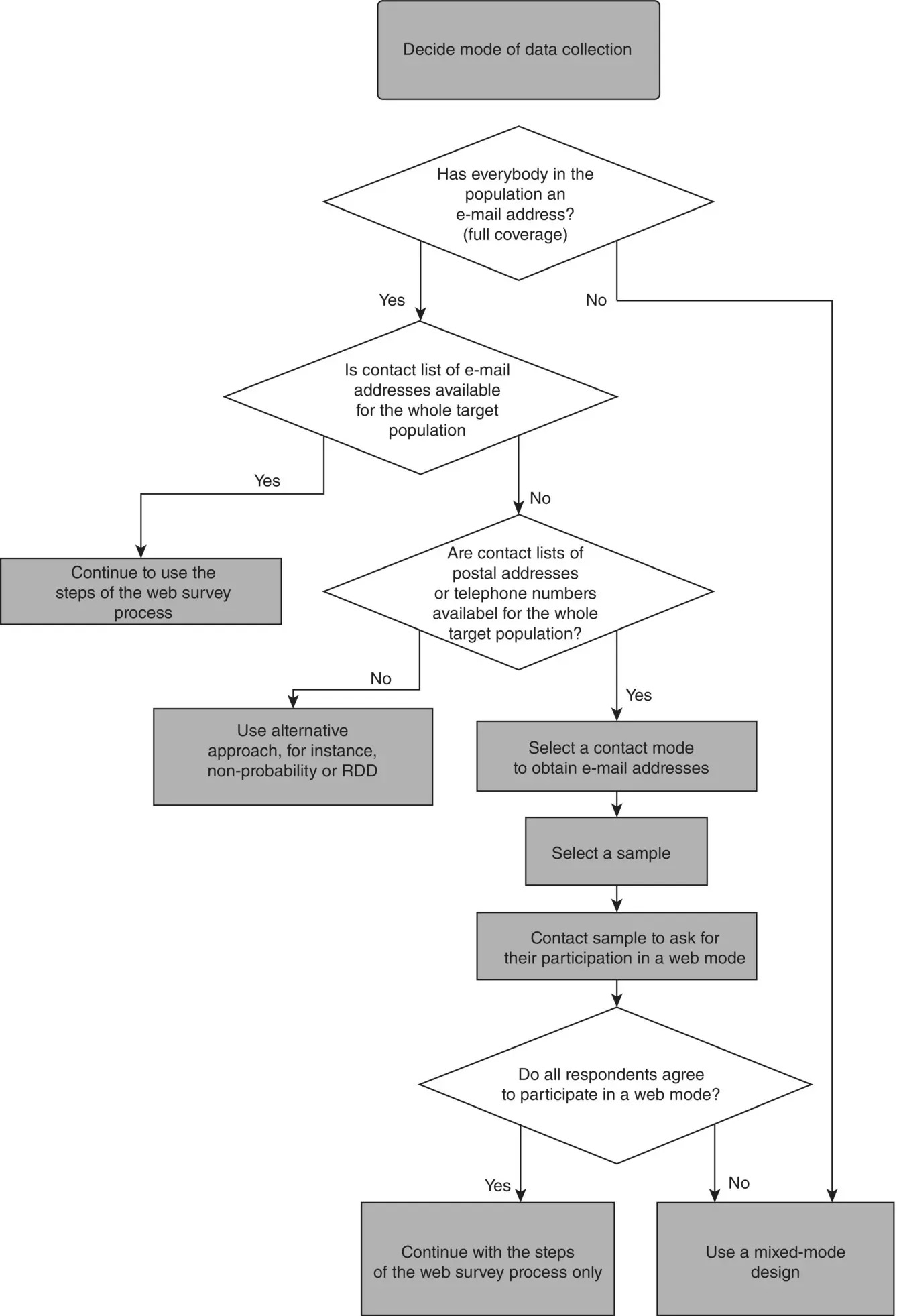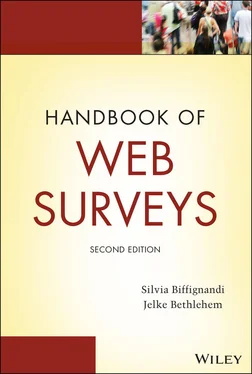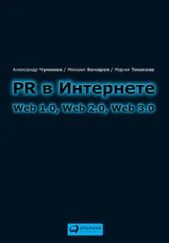If the variable is not precisely declared, the respondents could compile the questionnaire according different concepts; one could exclude part‐time workers, whereas another could include them. Therefore, in such a survey, measurement error would arise, or a high number of nonresponses to the specific question (item nonresponse) would emerge due to the unclear variable definition.
Most statistical offices, both NSIs and various research bodies, present a section on metadata. Research institutes, marketing research societies, and every business or institution collecting survey data should provide a clear metadata definition and communicate it to the users.
The third step is the Designing the mobile web or web‐only survey; this may be broken down into sub‐steps. Firstly, two basic sub‐steps to consider are as follows: (1) decide if the study should be experimental or observational, and (2) decide the mode of data collection.
Regarding the sub‐step Decide if the study should be experimental or observational (sub‐step 1), it should be kept in mind that an experimental study tries to catch how different factors affect the results; thus, the task is to highlight relationships between factors and the results (or outputs). There is no special interest in estimating the values of the variables at the target population level. Observational studies, on the contrary, aim at estimating the values of the variables at the target population level. Designing a survey for an experimental study does not necessary require a probability‐based sample, because the major task is getting a sort of case study for investigating causal relationships. For example, in‐the‐moment surveys, typically reaching the interviewee on the smartphone, are often lacking in probability sampling criteria; thus, mostly they have just a value of experimental studies capturing emotions and opinion when the individual is experimenting some event or action. Observational studies focus at the level of variables estimation; therefore, the probability‐based sampling technique is crucial, and the sampling design is an important step. Socioeconomic surveys in general aim at the estimation of the whole target population estimates.
Sub‐step B, Deciding the mode of data collection, is important because it verifies if organizing a survey only via the web (or mobile web) is feasible and effective. Criteria for mode selection are general and related to several aspects of the research environment and the specific issue. A mobile web survey or a web survey in general, because it is self‐completed, fits extremely well for sensitive research questions and/or for short and simple questionnaires. Efficient implementation of complex questionnaires may be efficiently implemented; this happens particularly in official statistics. Web only or mobile web in this case is more problematic; mixed-mode is preferable. One relevant constraint in the use of a probability‐based mobile web survey is the availability of an adequate sampling frame. Thus, the choice of the mode depends on many factors, and a critical one is the sampling frame availability. An inadequate mode choice might let many types of errors arise (coverage errors, extremely high unit nonresponse, and so forth) bringing about a poor‐quality result. Due to the importance of an adequate mode selection for a probability‐based mobile web survey, Thorsdottir and Biffignandi present a flowchart to show the major steps driving the mode choice. Figure 3.2presents the actions and the decisions to be undertaken when choosing the mode of data collection.
Moving to Figure 3.2, when selecting the mode, the first problem is deciding if it is possible to draw a probability‐based survey from target population under study, i.e., the question is if everyone does have an e‐mail address. If everyone has an e‐mail address and a complete list (good sampling frame) is available, then it is possible to proceed with the web‐only survey. However, if the list of e‐mail addresses is incomplete (bad sampling frame) or does not exist, the surveyor must decide if an alternative sampling frame is available, for example, a sampling frame of telephone numbers or postal addresses. If the alternative sampling frame is available, a mixed‐mode approach should be adopted. The surveyor should select a contact mode (telephone or mail) and approach the sampled interviewees to ask them to participate in the survey and if they can provide an e‐mail address or not. If the researcher intends to conclude the survey via web, he can provide a personal computer and Internet access (with e‐mail address) to those without Internet and e‐mail address. In this case, the data collection takes place via a web or mobile web survey. Thus, from this step of Figure 3.2, it is possible to follow the decision steps of the flowchart in Figure 3.1. Whether the researcher don't want to provide Internet access or interviewees do not agree to participate via the web or if they do not provide an e‐mail address, the interview should be administered using an alternative mode. In such a case, the surveyor must run a mixed‐mode survey with a web component (see Chapter 9). In this case also, from this step of Figure 3.2, it is possible to follow the decision steps of the flowchart in Figure 3.1.

Figure 3.2 Sub‐steps for deciding the mode of data collection
If no alternative sampling frame exists, only a non‐probability approach is possible, or an RDD telephone contact could be undertaken. 3
There are considerable advantages associated with web/mobile web survey compared with face‐to‐face, mainly in term of cost and timeliness. However, web mode does perform more poorly in terms of coverage and participation. For this reason, researchers sometimes consider using a mixed‐mode approach including web, even if no problem exists in term of sampling frame (see experiments and comments in Jäckle, Lynn, and Burton, 2015).
If the conditions to a web survey are present, the surveyor will return to the steps and sub‐steps of the Figure 3.1flowchart.
At this stage, the sub‐step to be faced is to Define the sampling frame and the sampling approach . This refers only to probability‐based surveys. The identification of the sampling frame requires a complete e‐mail list of the target population; thus, the entire target population should be online and listed (e‐mail list) without under‐coverage or duplications. 4 Once the sampling frame and the sampling approach is decided, the sample selection takes place (see Chapter 4about sampling problems and methods). Sampling strategies do not differ from those of traditional surveys. Other sub‐steps are the Questionnaire design and the Design paradata methodology . It is possible to work on in a parallel way. Paradata are usually “administrative data about the survey,” and, during the data collection, they are gathered. Web survey paradata include how many times the respondent had been accessing the questionnaire, item nonresponses, editing errors, and the time the questionnaire was completed. Thus, there are paradata about each observation in the survey. When considering mobile web surveys, a variety of devices could be used to complete the questionnaire; therefore paradata include the type of device, possibly the device where the survey contact/questionnaire is opened and the one from which the completed questionnaire is submitted. Paradata are useful for understanding problems in the questionnaire. For example, questions not clear enough or ambiguous are identified. Usually unclear questions present plenty of item nonresponse and higher response time, and/or they are inducing up and down navigation in the questionnaire. When monitoring survey participation, paradata are useful in order to allow for additional strategies in the solicitation process. For example, looking at the characteristics of the respondents during the data collection, it is possible to use adaptive design (see Chapter 8). This brings to higher response rate and limited costs. Paradata also provide insights into the under‐coverage and over‐coverage. In summary, paradata are an interesting information source that can improve the survey process and identify errors and their interrelations.
Читать дальше













